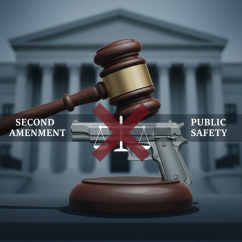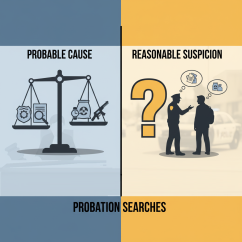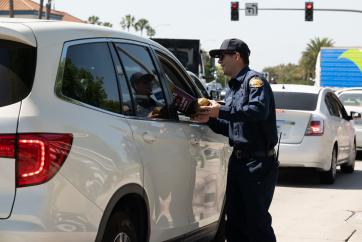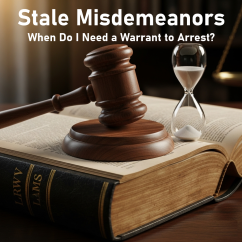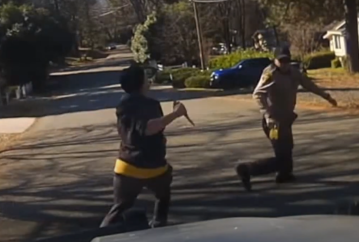

- Ref # CAC00091
- January 08, 2023
Spotlighting Suspect Vehicles
- Spotlighting a Vehicle
- Totality of the Circumstances; Consensual Encounters vs. Detentions
- A “Show of Authority” and Detentions
The police illuminating the inside of a vehicle with a spotlight does not constitute a detention absent other circumstances that would cause a reasonable person to believe he was not free to leave. Whether or not a police officer illuminating a vehicle’s interior with his or her spotlight constitutes a “show of authority” sufficient to cause a detention of the vehicle’s occupants requires a consideration of the totality of the surrounding circumstances.
At around 8:45 p.m. on a March evening (relevant only to the fact that it was dark out), San Joaquin County Sheriff’s Deputy Joel Grubb, in uniform, was patrolling a Stockton residential neighborhood in a marked patrol car with his headlights’ high beams on for “extra visibility.” The area was known for narcotics sales and weapons possession. Deputy Grubb drove past a BMW legally parked in front of a residence close to a streetlight. Although the car’s engine and headlights were off, smoke visibly emanated from the “slightly cracked” windows. As he passed the BMW, Deputy Grubb made eye contact with the three occupants; two of whom were wearing hooded sweatshirts and comfortably reclining in the front seats. The third occupant was in the rear seat. Making a U-turn, Deputy Grubb pulled up to and parked within 15 to 20 feet behind the car without blocking it in. The deputy turned his spotlight on, shinning it into the rear window of the BMW. He did not use either his overhead emergency lights nor his siren. After taking about 15 to 20 seconds to inform dispatch of his location, Deputy Grubb got out of his patrol car and walked up to the BMW at a normal pace. As he did so, a woman—the backseat passenger—“jumped out” of the BMW, closing the door behind her. Deputy Grubb later testifying that “[i]t was very quick and kind of abrupt the way that she opened the door and quickly stepped out. I felt it was unusual.” As she walked back towards the rear of the BMW, Deputy Grubb asked her what she was doing. She responded; “I live here.” Concerned for his safety, Deputy Grubb told her in a “calm and moderate voice” to stand near the sidewalk behind the BMW where he could keep an eye on her. The woman complied. Continuing to walk towards the driver’s side of the car and coming up to within a few feet of it, Deputy Grubb could smell marijuana smoke coming from inside. Illuminating the rear passenger area of the car (which had tinted windows) with his flashlight, he observed one large and two smaller clear plastic bags on the floorboard containing a green leady substance he recognized to be marijuana. Deputy Grubb then contacted the driver (defendant), who verbally identified himself when asked as Leon William Tacardon. The passenger produced identification. While talking with defendant, Deputy Grubb saw a partially burned, hand-rolled cigarette in the center console. When asked, defendant admitted to being on probation. A records check done minutes later confirmed that fact, and that his probation was subject to search and seizure conditions (i.e., a “Fourth waiver”). With everyone put into the back seat of the patrol car, a search of the BMW resulted in the recovery of the three baggies of marijuana (696 grams of the stuff) and a vial containing 75 pills (later determined to be hydrocodone). Searching defendant incident to his arrest resulted in the recovery of $1,904 in cash. Charged in state court with possession for sale of hydrocodone and marijuana, defendant’s motion to suppress (per P.C. § 1538.5) made at the preliminary examination, arguing that all his dope and the money were the products of an illegal detention, was denied. However, upon refiling his suppression motion as a part of a motion to dismiss (pursuant to P.C. § 995) at the trial court level, the motion was granted. The People appealed. The Third District Court of Appeal reversed, upholding the detention and the subsequent search. (See People v. Tacardon (July 22, 2020) 53 Cal.App.5th 89, briefed at California Legal Update, Vol. 25 #10; Aug. 19, 2020.) Defendant appealed to the California Supreme Court.
The California Supreme Court, in a 6-to-1 decision, affirmed. The issue in this case was when, in the sequence of events, defendant was detained; i.e., before or after Deputy Grubb had the necessary reasonable suspicion to justify the detention. If his detention occurred prior to Deputy Grubb’s observation of the marijuana on the backseat floor of defendant’s car and the smelling of the marijuana smoke emanating through its partially closed windows, then everything subsequently seen and found should have been suppressed as the product of an illegal detention. If after, then his motion to suppress was properly denied. Defendant argued that he was detained upon Deputy Grubb shining his (Deputy Grubb’s) spotlight into his (defendant’s) car. The People argued that defendant was not detained until Deputy Grubb observed the marijuana and smelled of the smoke emanating from his car. So the main issue here is the legal effect of an officer spotlighting a suspect’s vehicle; i.e., does such spotlighting constitute a detention of the occupants of that car? The law is clear that there is nothing illegal with a law enforcement officer approaching people on the street and engaging them in a consensual conversation, or even questioning them, so long as the persons so contacted are willing to answer questions. “Such consensual encounters present no constitutional concerns and do not require justification.” (People v. Brown (2015) 61 Cal.4th 968, 974.) “So (per the Court) merely walking up to someone in a parked car is not a detention.” However, a person may be considered detained when and if an officer exhibits a “show of authority” sufficient to cause the person contacted to no longer feel that he or she is free to leave. In such a circumstance, the officer must have had at least a “reasonable suspicion” that the person so detained is involved in illegal activity. (Terry v. Ohio (1968) 392 U.S. 1, 12, 15, 21–22.) “In situations involving a show of authority, a person is seized (i.e., detained) ‘if “in view of all of the circumstances surrounding the incident, a reasonable person would have believed that he was not free to leave,”’ or ‘“otherwise terminate the encounter”’ [citation], and if the person actually submits to the show of authority.” (Ibid.) In evaluating such a circumstance, a court must consider the “totality of the circumstances.” (Florida v. Bostick (1991) 501 U.S. 429, 437; Michigan v. Chesternut (1988) 486 U.S. 567, 572.) Also, the test is not what the person contacted (or the officer himself) may have believed, but what a “reasonable person” under the circumstances would have believed. (In re Manuel G. (1997) 16 Cal.4th 805, 821.) Factors to consider include (but are not limited to) the presence of multiple officers, an officer’s display of a weapon, the use of the officer’s siren or overhead emergency lights, physically touching the person, the use of a patrol car to block movement, or the use of language or of a tone of voice indicating that compliance with the officer’s request is compelled. (See Michigan v. Chesternut, supra, at p. 575; In re Manuel G., supra.) With these principles in mind, the Court here looked at the circumstances present in this case. It was agreed by the parties that Deputy Grubb had no reasonable suspicion to believe defendant was engaged in criminal activity up until that point when the deputy observed the marijuana on the floor of defendant’s vehicle and smelled the marijuana smoke. So the issue debated here was whether spotlighting a person’s vehicle—which occurred prior to the deputy having a reasonable suspicion—constitutes a detention. The weight of authority is that it does not, at least absent other factors being involved (the Court citing about a half-dozen cases to that affect). The one California case cited that held otherwise is People v. Kidd (2019) 36 Cal.App.5th 12. (See brief at California Legal Update; Vol. 24 #10; Sept. 21, 2019) In Kidd, the Appellate Court found the use of a spotlight as essentially indistinguishable from the activation of a police car’s red and blue emergency lights. The Court here specifically disagreed with the Kidd decision, noting that it conflicted with the weight of authority. While it is recognized that a police vehicle’s emergency red and blue lights, when shined at a suspect’s vehicle, communicate to any reasonable person the fact that they are being commanded to submit to a detention (People v. Brown, supra, at pp. 972-978.), the same is not necessarily true when it is a patrol vehicle’s white spotlight that is being used. As a general rule, the use of a spotlight (even if in addition to the use of the police vehicle’s high beams) does no more than convey to the reasonable person that he may be the “object of official scrutiny.” Such “official scrutiny,” however, “does not amount to a detention” absent other factors indicating to the contrary. (See People v. Perez (1989) 211 Cal.App.3rd 1492, 1496.) In this case, the Court held that it could find no such additional factors sufficient to elevate the contact into a detention. Defendant was not stopped by Deputy Grubb. Defendant and his companions were already parked. Deputy Grubb made a U-turn and parked some 15 to 20 feet behind him, but did not block him in. The deputy then took his time getting out of his patrol vehicle (up to 20 seconds) before walking up to defendant’s car at a normal pace, and without any weapons drawn. Deputy Grubb made no demands nor issued any commands. Nothing occurred in this sequence of events, other than the shinning of the deputy’s spotlight, to indicate an intent to do anything other than conduct a consensual encounter. Without more, the Court held that this did not amount to a detention. The one factor not decided by the lower courts, however, was the possible legal effect of Deputy Grubb ordering the female passenger—who had alighted from the car on her own initiative—to stand near the sidewalk behind defendant’s vehicle. More specifically, it was unknown whether defendant had heard that exchange between the female and Deputy Grubb, and if so, what effect it might have had on the issue of whether a reasonable person in defendant’s position under those circumstances would have felt that he was no longer free to leave. This, of course, is important in that it all occurred before Deputy Grubb smelled the marijuana and observed the marijuana baggies in defendant’s car; i.e., before he had the necessary reasonable suspicion to justify a detention. The Court therefore remanded the case back to the trial court for a determination of whether defendant heard Deputy Grubb detain the female, and, if so, what effect that fact might have had on a reasonable person in defendant’s position.
Kudos to DDA Cindy De Silva of the San Joaquin DA’s Office for recognizing the issues here and pushing this case through to a successful conclusion. But note that it is not over yet. Recognizing that the California Supreme Court emphasized in this decision that it is not the Court’s intention to establish a “bright line rule,” but rather that the “totality of the circumstances” must be considered, we now have to do it all over again while taking into account the issue of whether the detention of the female passenger was heard by defendant, and if so, is this a factor, in conjunction with the use of the officer’s spotlight, sufficient to constitute a detention The dissent, authored by Justice Goodwin Liu (who never met an anti-police argument he didn’t like), also should not be ignored. Justice Liu, in his typically well-reasoned and thorough dissenting opinion, commented simply that the majority’s “conclusion does not accord with common sense.” Is he wrong Think about it: If a police officer drove up behind you and illuminated the interior of your car with his spotlight (whether you were smoking dope or not), do you really think you’d get away with just driving off And as an inquisitive cop, would you not take it as a challenge should the car you just illuminated with your spotlight suddenly decide to leave before you could consensually encounter its occupants (See Illinois v. Wardlow (2000) 528 U.S. 119; flight from the police in a “high-narcotics” area constitutes sufficient cause to detain.) But recognizing that “common sense” is not necessarily used in deciding today’s search and seizure decisions, we’ll just have to wait and see how this case turns out on its second trip through the courts.
